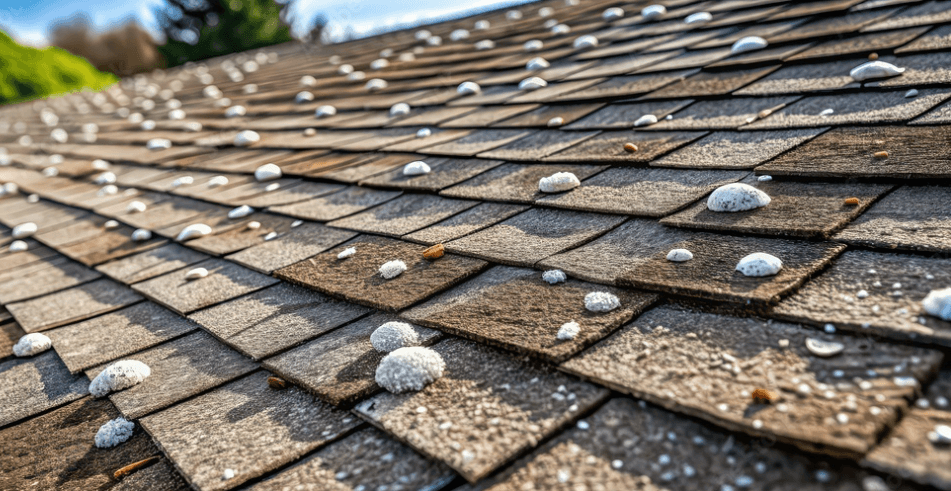Hail damage can be overwhelming, especially when it affects a critical part of your home: the roof. If your roof has been impacted by hail, filing an insurance claim is essential for protecting both your property and financial investment.” Some homeowners may hesitate to file a claim due to concerns about increased premiums or the complexity of the process. However, recognizing the advantages of filing can provide peace of mind and empower you to take the necessary steps.
This article highlights the importance of filing a hail damage claim, details the steps involved, and provides practical guidance for navigating the process. By addressing potential long-term issues and taking advantage of repair opportunities, understanding the claim process allows you to turn a stressful situation into a proactive strategy of maintaining and enhancing your home.
Understanding the Importance of Filing a Hail Claim
Filing a hail claim is an essential step for homeowners who have experienced roof damage due to a hailstorm. Recognizing the importance of this action can help safeguard both your property and financial investment. If not addressed promptly, roof damage can escalate, leading to significant repair expenses and long-term issues that could compromise the structural integrity of your home.
Protection Against Financial Loss
Filing a hail claim is vital for protecting your finances. Roof damage, if ignored, can lead to costly repairs, as explained here, especially when minor issues such as small dents or cracks worsen over time. By submitting a claim, you ensure coverage for necessary repairs, restoring your roof to its original condition and preventing further damage. This proactive step reduces financial strain and protects your home, avoiding even more expensive repairs in the future. Your insurance coverage alleviates the burden of unexpected repair costs, preserving your investment.
It Won’t Affect Your Insurance Premium
Homeowners often fear that filing an insurance claim will raise their premiums, but hail damage claims typically don’t lead to rate increases. Hailstorms are classified as an “Act of God,” meaning they are natural events beyond the homeowner’s control. Insurance companies generally don’t penalize policyholders for such claims. This allows you to confidently file a claim without worrying about a premium hike. By doing so, you can secure necessary repairs and protect your home without added financial burden.
Insurance Adjusters Will Assess the Damage
Once you file a hail damage claim, your insurance company will assign an adjuster to assess the situation. The adjuster plays a critical role in the process by thoroughly inspecting your roof and any other affected areas. Their professional evaluation determines the extent of the damage and the required repairs. By ensuring a comprehensive assessment, the adjuster helps you receive the appropriate compensation, giving you peace of mind as you move forward with repairs, knowing that your insurance provider is supporting you. Learn more about what to expect during an insurance adjuster’s assessment.
An Opportunity for Roof Improvement
Filing a hail damage claim also presents an excellent opportunity to upgrade your roof. If your roof has been damaged, it might be a good time to consider more durable materials like impact-resistant shingles or energy-efficient options like reflective coatings or improved insulation. These upgrades not only enhance your home’s appearance but also contribute to long-term savings on energy bills. Once your claim is approved, discussing these options with your contractor will help you make informed choices that improve your home’s durability and increase its value.
Preventing Long-Term Damage
Hail damage can sometimes be deceptive, with small dents or cracks that seem insignificant at first. However, these minor issues can lead to more serious problems like leaks, water damage, or even structural weaknesses if left unchecked. By filing a claim soon after the hailstorm, you take important steps to prevent further deterioration. Addressing the damage early can save you from costly repairs in the future and helps maintain your home’s value and structural integrity, ultimately saving you both time and money.
Timeliness is Essential
Timing is crucial when filing a hail damage claim. Insurance companies often have strict deadlines for submitting claims, typically requiring them to be filed within a year of the hailstorm. Delaying could result in missing out on valuable coverage, forcing you to bear the cost of repairs yourself. If you suspect hail damage, it’s critical to contact your insurance provider immediately to initiate the claims process. Acting promptly ensures you can take full advantage of your coverage and protects your home from more severe, costly damage down the line.
The Hail Claim Process: A Step-by-Step Guide
The Hail Claim Process: A Step-by-Step Guide
Filing a hail damage claim can initially seem daunting, but understanding the process will make it far more manageable. Below is a step-by-step guide to help you navigate the hail damage claims process efficiently.
Step 1: Assess the Damage
After a hailstorm, your first concern is your safety and the condition of your home. Once it’s safe, inspect your property for visible signs of damage. Focus on your roof, gutters, windows, and other exterior areas. Document any findings with clear photographs, as this evidence will be essential when you file your claim. The More thorough your documentation, the smoother the claims process will be.
Step 2: Notify Your Insurance Company
After assessing the damage, promptly contact your insurance provider. Report the hailstorm and any damage to your roof or other parts of your home. Most insurance companies have dedicated claims departments and 24-hour emergency hotlines to assist with reporting claims quickly. Be prepared to provide detailed information about the storm, the extent of the damage, and any temporary repairs you may have made to prevent further issues. This step helps initiate your claim promptly and efficiently.
Step 3: Schedule an Adjuster’s Visit
Once your claim is filed, the insurance company will assign an adjuster to inspect the damage. It’s beneficial to have your contractor present during the adjuster’s visit, as they can provide additional expertise and ensure nothing is overlooked. Your contractor can also advocate on your behalf, ensuring that all damage is properly assessed. This collaborative approach increases the chances that the adjuster accurately documents the full extent of the damage, improving the likelihood of a fair settlement.
Step 4: Damage Evaluation
During the adjuster’s visit, they will thoroughly assess your roof and any other affected areas of your property. Based on their evaluation, the adjuster will determine if the damage qualifies for coverage under your policy. If the damage is deemed minor or not covered, the claim may be denied. Therefore, it’s critical to have detailed documentation and a professional inspection to support your case. The quality of the initial assessment can significantly impact the final outcome of your claim.
Step 5: Contractor Estimate or Insurance Estimate Submission
If the adjuster approves your claim, they will either provide an estimate for the necessary repairs or allow your contractor to submit a detailed bid for the required work. This estimate process ensures that you receive the appropriate funds to cover repair costs. It’s important that your contractor provides a detailed, accurate estimate reflecting all necessary repairs and materials, so there are no surprises later. Double-check the estimate to ensure it includes all necessary aspects of the job, such as labor, materials, and any upgrades you may consider.
Step 6: Start the Repair Process
Once your claim is approved, and the funds are released, you can begin the repair process. This is an excellent opportunity not only to fix the damage but also to improve your home with a new roof or upgraded materials. If your roof needs replacing, you can explore options that provide enhanced protection against future storms, such as impact-resistant shingles or energy-efficient materials. Discuss these possibilities with your contractor to maximize the benefits of your insurance claim and improve the overall durability and energy efficiency of your home.
By following these six steps, you’ll be better prepared to navigate the hail damage claim process. Taking prompt action, documenting damage thoroughly, and working closely with both your contractor and insurance company will help ensure a smooth experience and successful outcome. Whether you’re addressing minor repairs or replacing your roof entirely, understanding each stage of the claim process will help you protect your home and investment.
Conclusion
Filing a hail damage claim is not only a wise financial decision but also essential for preserving the safety and integrity of your home. By submitting a claim, you safeguard your investment, maintain stable insurance premiums, and may even have the opportunity to upgrade to more durable or energy-efficient roofing materials. The advantages of filing a claim far outweigh any initial hesitations. Timing is crucial—acting swiftly after a hailstorm is key to securing the coverage you need.
Though the claims process might feel overwhelming, understanding each step simplifies the experience. Filing promptly ensures your home receives necessary repairs and protection from future problems. If you have concerns, reach out to your insurance representative or a trusted contractor. Taking proactive steps will keep your home safe, secure, and well-maintained for years to come. If you have concerns, reach out to your insurance representative or a trusted contractor.”

